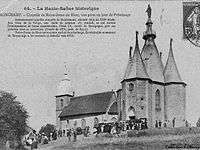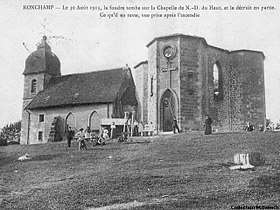Bourlémont
Bourlémont is a hill located in Ronchamp, Haute-Saône, eastern France with an elevation of 474 m (1,555 ft) above sea level.[1] It is located in the Ballons des Vosges Nature Park, and is an area of cultural tourism, given that the chapel of Notre Dame du Haut is located on it.
| Bourlémont | |
|---|---|
Bourlémont overlooking Ronchamp | |
| Highest point | |
| Elevation | 474 m (1,555 ft) [1] |
| Coordinates | 47°42′17″N 6°37′12″E |
| Geography | |
 Bourlémont Location of Bourlémont in France | |
| Location | Ronchamp, Haute-Saône, Franche-Comté, France |
| Parent range | Vosges |
Toponymy
In the 18th century, Bourlémont was described as "Notre-Dame-de-Bourg-les-monts", which indicates that there was a fortified town on the hill.[2] At the beginning of the nineteenth century, the hill was called the "Bourg Mountain".[2]
Geography
Bourlémont is located in Ronchamp, Haute-Saône, Franche-Comté, France. It can be accessed from Chapel Street on the southeastern side of the summit and the Way of the Cross footpath which was created in 1890.[2][3] The GR 59 and Dukes hiking trails pass along the eastern side of the hill.[4]
The hill has an altitude of 474 m (1,555 ft), meaning that it is 121 m (397 ft) higher than the centre of Ronchamp (353 m (1,158 ft)), which is at the foot of the hill.[5]
Bourlémont is mainly composed of red sandstone, but there is also a presence of argillite, quartzite and shale.[2] The climate of the hill has continental and oceanic influences, and it experiences very low winter temperatures.[2][6]
History


In ancient times, a Roman temple stood on top of the hill, and in 1092 a Catholic church was built at the same location.[7] In the eighteenth century, gallows existed on the southern flank of the hill, the remains of which still exist. During the Thirty Years' War, Girardot de Noseroy considered building a fort on the hill, but these plans were abandoned given the maintenance cost and weather conditions.[2]
At the start of the eighteenth century, the chapel on the hill was the only parish church in Ronchamp and the surrounding hamlets.[6] During the French Revolution, ownership of the chapel changed many times. On 27 July 1796, it was sold to Jean-Jacques Marsault for 600 livres. On 28 January 1797 it was sold to Claude François Billy for 875 livre. In 1801, the chapel became a public place of worship, but remained guarded.[6]
Between 1844 and 1857, a new shrine was constructed in the shape of a cross, which was 20 m (66 ft) long and 15 m (49 ft) wide, which was connected to the chapel. On 8 September 1873 the chapel held a large pilgrimage, where 30,000 people from Alsace, Lorraine and Franche-Comté visited the chapel.[7] In the 1880s, a cottage was built near the chapel, which was occupied until the 1970s when it collapsed. A footpath was constructed in 1890 to assist hikers and pilgrims to reach the chapel, known as the Way of the Cross.[3][7]
On 30 August 1913, a hail storm broke out above Ronchamp. At around 11am, the bell tower of the shrine was struck by lightning which triggered a fire, leaving only the stone walls of the sanctuary, but the chapel was untouched.[8]
A new chapel was built on Bourlémont between 1950 and 1955, and in 1965 the chapel was registered as a monument historique.[9]
On 29 March 2001, the headframe of Sainte Marie Coal Mine located in the hill was listed as a twentieth-century Monument historique.[10]
References
- "Le portail des territoires et des citoyens". Geoportail. Retrieved 20 October 2014.
- "Bourlémont". Friends of Mine Museum. Retrieved 20 October 2014.
- PNRBV (1999). Le charbon de Ronchamp. Déchiffrer le patrimoine, parc naturel régional des Ballons des Vosges. ISBN 2-910328-31-7.
- "The tour of the dukes". Visugpx. Retrieved 20 October 2014.
- "Ronchamp". Ronchamp. Retrieved 20 October 2014.
- "Bourlémont". Friends of Mine Museum. Retrieved 20 October 2014.
- "Bourlémont". Friends of Mine Museum. Retrieved 20 October 2014.
- "Bourlémont". Friends of Mine Museum. Retrieved 20 October 2014.
- "Bourlémont". Friends of Mine Museum. Retrieved 20 October 2014.
- Mérimée IA70000154, Ministère français de la Culture. (in French) et Mérimée PA70000053, Ministère français de la Culture. (in French)